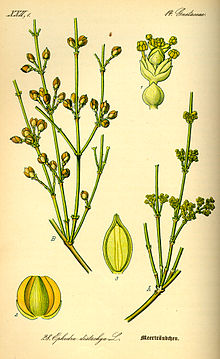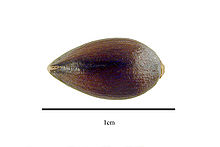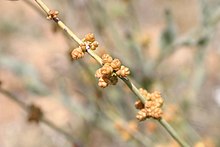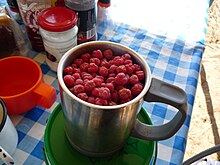Sea ravages
| Sea ravages | ||||||||||||
|---|---|---|---|---|---|---|---|---|---|---|---|---|

Ephedra fragilis in Mallorca |
||||||||||||
| Systematics | ||||||||||||
|
||||||||||||
| Scientific name | ||||||||||||
| Ephedra | ||||||||||||
| L. |
Ephedra ( Ephedra [ eːfɛdra ], from gr. Ἐφέδρα ephedra "ponytail") is the only genus of the plant family of Meerträubelgewächse (Ephedraceae) within the order Gnetales . This genus has a disjoint area with each part of the 35 to 70 species in the Old World and the New World .
description



Vegetative characteristics
Sea crow species are woody plants: mostly cane bushes , sometimes climbing plants. The opposite or threes quirlig arranged sheets are imbricated reduced. The photosynthesis take the branched, greenish branches.
Generative characteristics
The flowers are always unisexual. Most of the species are dioecious ( dioecious ), rarely the flowers monoecious ( monoecious ) separate sexes. The male cones stand individually or in twos or threes at the nodes (nodes). In the male cones, the membranous bracts stand in two to eight whorls in pairs or in threes. The female cones are opposite to each other or three to four in whorls in the nodes. In the female cones, the overlapping bracts stand in two to ten whorls in pairs or threes. The bracts usually become fleshy and red when the seeds are ripe (they rarely remain membranous and turn brownish). The female flowers have a pair of overgrown, leathery scales. The sea robbers are counted among the naked men; their ovules are therefore not protected by carpels. One to three yellow to dark brown seeds are formed per cone .











Systematics and distribution
The genus Ephedra was established by Carl von Linné . The scientific name Ephedra was coined by the ancient Greek author Dioscurides . However, it is not clear whether this actually meant ephedra or not a horsetail . Ephedra is often confused with horsetail or gorse species because it is similar at first glance . A synonym for Ephedra L. is Chaetocladus J. Nelson
The genus Ephedra has a disjoint area : It is found in the Old World from the Amur region via Arabia to Portugal , but also in North Africa, in Eastern Africa and on the Canary Islands ; in the New World in parts of the United States , Mexico, and South America . They usually thrive in arid areas, on sand or rocks, they are rarely found in grasslands . There are 35 to 70 species of ephedra worldwide . 21 species occur in Eurasia , 14 of them in China. Twelve species are native to the USA, five of which are also found in Mexico; only one of these five species also grows in Argentina and Chile.
There are about 70 types of ephedra :
-
Ephedra alata Decne. : There are three subspecies:
- Ephedra alata Decne. subsp. alata (Syn .: Ephedra altissima Bové nom. illeg. non Desf. ): It occurs from the Sahara to the Arabian Peninsula .
- Ephedra alata subsp. alenda (Stapf) trot. (Syn .: Ephedra alata var. Alenda Stapf , Ephedra alenda (Stapf) Andr. ): It occurs from North Africa to Mauritania .
- Ephedra alata subsp. monjauzeana Dubuis & Faurel : It only occurs in Algeria .
- High sea riot ( Ephedra altissima Desf. ): There are two varieties:
- Andean sea puff ( Ephedra americana Humb. & Bonpl. Ex Willd. ): It occurs from Ecuador to northwestern Argentina .
- Ephedra antisyphilitica Berland. ex CAMey. : It has a disjoint area on the one hand in the US states of Oklahoma and Texas and on the other hand in the Mexican states of Nuevo León and San Luis Potosí .
- Ephedra aphylla Forssk. : It occurs from the eastern Mediterranean to the Arabian Peninsula .
- Ephedra × arenicola H.C. Cutler = Ephedra cutleri × Ephedra torreyana : This endemic species only occurs in Arizona .
- Ephedra aspera Engelm. ex S. Watson : It is common in the US states of Arizona, California , New Mexico , Texas and northern Mexico.
- Ephedra aurantiaca Takht. & Pachom. : It occurs from Transcaucasia to Central Asia .
- Ephedra boelckei F.A. Roig : This endemic only occurs in northwestern Argentina.
- Ephedra botschantzevii Pachom. : It occurs from southern Siberia to Central Asia.
- Ephedra breana Phil . : It occurs from southeastern Peru to northwestern Argentina.
- Ephedra brevifoliata Ghahr. : It only occurs in Iran .
- Ephedra californica S. Watson : It occurs in California and in Baja California ,Mexico.
- Ephedra chilensis C. Presl : It occurs from Chile to western Argentina.
- Ephedra compacta Rose : Your home is Mexico.
- Ephedra coryi E.L. Reed : It thrives in sandy, semi-arid areas at altitudes of 500 to 2300 meters in the US states of New Mexico and Texas .
- Ephedra cutleri Peebles : It thrives at altitudes of 1400 to 2300 meters in the US states of Arizona, Colorado , New Mexico and Utah .
- Ephedra dahurica Turcz. : It occurs from southern Siberia to Mongolia .
- Ephedra dawuensis Y.Yang : It wasfirst describedin 2005 from Sichuan .
-
Ephedra distachya L .: There are two subspecies:
- Common sea pigeon ( Ephedra distachya L. subsp. Distachya , Syn .: Ephedra monostachya L. , Ephedra polygonoides Pall. Nom. Illeg., Ephedra vulgaris Rich. Nom. Illeg., Ephedra minor Host , Ephedra botryoides Fisch. , Ephedra media CAMey . , Ephedra subtristachya . C.A.Mey , ephedra arborea . lag ex Bertol. , Ephedra clusii Dufour , ephedra macrocephala Bertol. , Ephedra maritima St. lag. , Ephedra dubia rule , ephedra podostylax Boiss. , Ephedra linnaei Stapf ex Koehne ): you is widespread from Kazakhstan through West and Central Asia to Xinjiang .
- Swiss ephedra ( Ephedra distachya subsp. Helvetica (Camey.) Asch. & Graebn. , Syn .: Ephedra helvetica C.A.Mey. , Ephedra vulgaris subsp. Helvetica (Camey.) Nyman , ephedra rigida St. lag. , Ephedra Negrii Nouviant ) : In the Alps, it only thrives in Switzerland and Italy .
- Ephedra × eleutherolepis V.A.Nikitin = Ephedra intermedia × Ephedra strobilacea : It occurs only in Tajikistan .
- Mongolian ephedra ( Ephedra equisetina Bunge , Syn .: Ephedra nebrodensis subsp. Equisetina (Bunge) Breistr ex Greuter & Burdet. , Ephedra shennungiana Tang , ephedra equisetina var. Monoica Y.Yang ): It is from Kazakhstan, Kyrgyzstan , Tajikistan , Turkmenistan , Uzbekistan , Russia , Afghanistan and Mongolia spread to China.
- Ephedra fasciculata A. Nelson : It thrives at altitudes of 300 to 1200 meters in the US states of Arizona, California, Nevada and Utah.
- Ephedra fedtschenkoae Paulsen : It is distributed from Kazakhstan and Tajikistan via Mongolia to Xinjiang .
- Ephedra foeminea Forssk. : It occurs from southeast Europe to northeast tropical Africa.
- Ephedra foliata Boiss. ex CAMey. (Syn .: Ephedra ciliata Aitch. ): It occurs from North Africa to India .
-
Ephedra fragilis Desf. : There are two subspecies:
- Ephedra fragilis subsp. cossonii (Stapf) Maire : It occurs in northwestern Africa.
- Ephedra fragilis Desf. subsp. fragilis : It occurs in Macaronesia and in the western to central Mediterranean region.
- Ephedra frustillata Miers : It occurs in Chile and southern Argentina .
- Ephedra funerea Coville & CVMorton : It thrives at altitudes of 500 to 1500 meters in the US states of California and Nevada.
-
Creeping sea bark ( Ephedra gerardiana Wall. Ex Stapf ): There are two subspecies:
- Ephedra gerardiana Wall. ex Stapf var. gerardiana : It is distributed from Tajikistan , Afghanistan via Pakistan , northern India , Nepal , Sikkim , to Tibet , Qinghai and Xinjiang .
- Ephedra gerardiana . Var sikkimensis Stapf (Syn .: Ephedra saxatilis var. Sikkimensis (Stapf) Florin , ephedra gerardiana var. Saxatilis Stapf , Ephedra saxatilis (Stapf) Royle ex Florin , ephedra gerardiana var. Congesta C.Y.Cheng ): It is from Bhutan, Nepal and Sikkim spread to southern Tibet and northern Yunnan .
- Ephedra glauca rule : It occurs from Iran to Mongolia .
- Ephedra holoptera Riedl : It only occurs in Iran.
- Ephedra intermedia Schrenk & CAMey. : She is from Southwest Asia , Kazakhstan, Kyrgyzstan , Tajikistan, Turkmenistan , Uzbekistan , Southwestern Siberia , Afghanistan , Pakistan , Mongolia, Inner Mongolia , Tibet and the Chinese provinces of Gansu , Hebei , Liaoning , Ningxia , Qinghai , Shaanxi , Shandong , Shanxi and Xinjiang .
- Ephedra × intermixta H.C. Cutler = Ephedra trifurca × Ephedra torreyana : It occurs only in New Mexico.
- Ephedra kardangensis P.Sharma & PLUniyal : It was first described in 2010. The home is the western Himalayas.
- Ephedra khurikensis P.Sharma & PLUniyal : It was first described in 2010 and occurs only in the western Himalayan region.
- Ephedra laristanica Assadi : It only occurs in Iran.
- Ephedra likiangensis Florin : It thrives in the mountains at altitudes of 2300 to 4200 meters in the Chinese provinces of western Guizhou , western Sichuan , northwestern Yunnan and eastern Tibet .
- Ephedra lomatolepis Schrenk : It is common in Kazakhstan, southwestern Mongolia and Xinjiang .
- Nebroden-ephedra ( Ephedra major Host , Syn .: Ephedra nebrodensis Tineo , ephedra graeca C.A.Mey. , Ephedra equisetiformis Webb & Berthel. , Ephedra vulgaris Willk. , Ephedra villarsii Gren. & Godr. , Ephedra scoparia Lange , ephedra atlantica Andr. , Ephedra major var. Nebrodensis (Tineo) Hayek , Ephedra major var. Suggarica Maire , Ephedra major subsp. Villarsii (Gren. & Godr.) P.Fourn. , Ephedra major var. Atlantica (Andr.) Maire , Ephedra nebrodensis var. Scoparia (Lange) Nyman , Ephedra nebrodensis subsp. Suggarica (Maire) Breistr. Ex Greuter & Burdet ): It occurs from the Canary Islands across the Mediterranean to Mauritania.
- Ephedra milleri Friday & Maier-St. : It occurs only in Oman and Yemen .
- Ephedra minuta Florin : It thrives in the high mountains at altitudes of 2000 to 4800 meters in the Chinese provinces of Qinghai and Sichuan .
- Ephedra monosperma J.G. Gmel. ex CAMey. : It is distributed from Kazakhstan, Siberia , Mongolia, Pakistan to China.
- Ephedra multiflora Phil. Ex Stapf : It occurs in Chile and Argentina.
- Ephedra nevadensis S. Watson : It thrives at altitudes of 700 to 1900 meters in the US states of Arizona, California, Nevada, Oregon and Utah.
- Ephedra ochreata Miers : It occurs in Argentina.
- Ephedra oxyphylla Riedl : It occurs only in eastern Afghanistan.
-
Ephedra pachyclada Boiss. : There have been two subspecies since 1992:
- Ephedra pachyclada Boiss. subsp. pachyclada : It occurs from the Arabian Peninsula over southern Iran to Pakistan .
- Ephedra pachyclada subsp. sinaica (Riedl) Friday & Maier-St. (Syn .: Ephedra sinaica ): It occurs from the Sinai Peninsula to the Arabian Peninsula.
- Ephedra pangiensis Rita Singh & P.Sharma :First described in2015 from Himachal Pradesh .
- Ephedra pedunculata Engelm. ex S.Watson : It is widespread from Texas to northern Mexico.
- Ephedra pentandra Pachom. : It only occurs in Iran.
- Ephedra przewalskii Stapf : It is distributed from Tajikistan, Uzbekistan, Kazakhstan, Kyrgyzstan, Pakistan and Mongolia to China.
- Ephedra pseudodistachya Pachom. : It occurs from Siberia to Mongolia.
- Ephedra Regeliana Florin : It is distributed from Tajikistan, Uzbekistan, Kazakhstan, Kyrgyzstan, Afghanistan , Pakistan and northern India to Xinjiang .
- Ephedra rhytidosperma Pachom. : It occurs in Mongolia, Inner Mongolia (only in Helan Shan) and in the Chinese provinces of Gansu (only in Baoji Shan) and Ningxia (only in Helan Shan).
- Ephedra rituensis Y.Yang, DZFu & GHZhu : It was first described in 2003 and thrives at altitudes of 3200 to 4600 meters in Tibet .
- Ephedra rupestris Benth. : It occurs in Ecuador, Bolivia, Peru and northwest Argentina.
- Ephedra sarcocarpa Aitch. & Hemsl. : It occurs in southern Afghanistan and southwestern Pakistan.
- Chinese marauding ( Ephedra sinica Stapf ): It is common in Mongolia, Inner Mongolia and the Chinese provinces of Gansu, Hebei, Heilongjiang , Jilin, Liaoning, Ningxia, Shaanxi and Shanxi.
- Ephedra somalensis Friday & Maier-St. : It occurs only in Eritrea and northern Somalia .
- Ephedra strobilacea Bunge : There are two subspecies. They occur from Central Asia to Iran.
- Ephedra sumlingensis P.Sharma & PLUniyal : The home is the western and central Himalayas.
- Ephedra tilhoana Maire : It only occurs in Chad.
- Ephedra torreyana S.Watson : There are two varieties. They occur in the USA and northeastern Mexico.
- Ephedra transitoria Riedl : The distribution area extends from Syria to the Arabian Peninsula.
- Ephedra triandra Tul. : It occurs in Bolivia and Argentina.
- Ephedra trifurca Torr. ex S.Watson : It is common in the US states of Arizona, Colorado, Nevada, New Mexico, Texas and Utah and in the Mexican state of Chihuahua .
- Ephedra trifurcata Zöllner : It is distributed in the US states of Arizona, California, New Mexico and Texas and in the Mexican states of Baja California, Chihuahua, Coahuila and Sonora .
- Ephedra tweedieana C.A.Mey. : It occurs in southern Brazil, Uruguay and northeast Argentina.
- Ephedra viridis Coville : It thrives at altitudes of 800 to 2500 meters in the US states of Arizona, California, Colorado, Nevada, New Mexico, Oregon, Utah and Wyoming .
- Ephedra vvedenskyi Pachom. : The distribution area extends from the eastern Transcaucasia to southern Turkmenistan.
- Ephedra yangthangensis P. Sharma & Rita Singh : It was first described in 2016 and occurs in the western-central Himalayas.
ingredients
Types of ephedra mostly, but not always, contain cardiovascular alkaloids such as ephedrine , norephedrine , pseudoephedrine , norpseudoephedrine , methylephedrine and methylpseudoephedrine. The chemical structure of these phenylethylamines is similar to that of adrenaline . Due to their stimulating effect , the potential for dependence is increased; Ephedrine therefore requires a prescription. The active ingredient content differs from plant to plant, but also from one season to another. Contents of 0.5 to 49 mg total alkaloids per 1 g of various ephedra preparations were found in various studies. The two main alkaloids ephedrine and pseudoephedrine made up 70 to 99 percent of the total alkaloid content. The ephedrine content was between 0 and 90 percent of the total alkaloid content, the pseudoephedrine content between 0.1 and 99 percent.
The concentrations of the ephedra alkaloids were investigated for the following species (selection); the concentrations are given in mg per 1 g of ephedra preparation:
| Ephedra style | Ephedra alkaloids |
|---|---|
| Ephedra sinica | 10-42 mg / g |
| Ephedra equisetina | 22-49 mg / g |
| Ephedra intermedia | 5-18 mg / g |
| Ephedra distachya | no information |
| Ephedra Regeliana | 20-32 mg / g |
| Ephedra major | no information |
| Ephedra monosperma | 28 mg / g |
| Ephedra lomatolepis | 13.6 mg / g |
use
The names of the drug are, for example, seaweed, ephedra herb, ephedrae herba. The drug is a pharmaceutical drug monographed in the European Pharmacopoeia with a total alkaloid content of 1 to 2% on average, which can, however, fluctuate widely. Ephedra herb extracts (tea) are indicated for respiratory diseases with mild bronchospasm , but the broncholytic effectiveness is uncertain. Ephedra herb can no longer be purchased in German pharmacies without a prescription, since ephedra species and their preparations were included in the Medicines Prescription Ordinance with effect from April 1, 2006 and thus became a prescription. Ephedra (sea beasts) also falls into category 1 of the Basic Substance Monitoring Act (GÜG), since the ephedrine it contains serves as a starting material for the illegal chemical synthesis of methamphetamine ( meth ), a drug with a high potential for dependence and toxic effects. In Europe, ephedra herb was first mentioned in Adam Lonitzer's book of herbs in 1557 .
"Mormon tea" is an infusion from the shoot axes of Ephedra nevadensis , which, when infused with an acidifier such as lemon juice , contains a considerable amount of ephedrine . The name comes from the former usage among members of the Church of Jesus Christ of Latter-day Saints (often called " Mormons "), who are prohibited from drinking coffee and black tea in addition to alcohol .
As "Ma-Huang" ( 麻黃 ), ephedra herb is one of the remedies of choice in traditional Chinese medicine (TCM) for the treatment of lung diseases or colds. It is usually combined with other medicinal herbs and used as a decoction .
literature
- Christopher J. Earle: Ephedraceae - Ephedra - Online. at The Gymnosperm Database , 2013. Last accessed May 6, 2019
- Liguo Fu, Yong-fu Yu, Harald Riedl: Ephedraceae. , P. 97 - online with the same text as the printed work , In: Wu Zheng-yi, Peter H. Raven (Ed.): Flora of China. Volume 4: Cycadaceae through Fagaceae , Science Press and Missouri Botanical Garden Press, Beijing and St. Louis, 1999, ISBN 0-915279-70-3 . (Sections systematics with dissemination)
- Dennis Wm. Stevenson: Ephedraceae. - Same text online as the printed work , In: Flora of North America Editorial Committee (Ed.): Flora of North America North of Mexico . Volume 2: Pteridophytes and Gymnosperms , Oxford University Press, New York and Oxford, 1993, ISBN 0-19-508242-7 .
- Stefanie Margot Ickert-Bond, Martin F. Wojciechowski: Phylogenetic Relationships in Ephedra (Gnetales): Evidence from Nuclear and Chloroplast DNA Sequence Data. In: Systematic Botany , Volume 29, Issue 4, 2004, pp. 834-849. doi : 10.1600 / 0363644042451143 Full text PDF.
- C. Rydin, KR Pedersen, EM Friis: On the evolutionary history of Ephedra: Cretaceous fossils and extant molecules. Proceedings of the National Academy of Sciences. 2004. Full text online.
Individual evidence
- ↑ a b Meerträubel at Tropicos.org. Missouri Botanical Garden, St. Louis, accessed on May 4, 2019.
- ↑ a b c d e f g h i j k l m n o p q r s t u v w x y z aa ab ac ad ae af ag ah ai aj ak al am an ao ap aq ar as at au av aw ax ay az ba bb bc bd be bf Rafaël Govaerts (Ed.): Ephedra. In: World Checklist of Selected Plant Families (WCSP) - The Board of Trustees of the Royal Botanic Gardens, Kew . Retrieved May 4, 2019.
- ↑ a b c d e f Christopher J. Earle: Ephedraceae - Ephedra - Online. at The Gymnosperm Database , 2013. Last accessed August 31, 2014
- ↑ a b c d Walter Erhardt , Erich Götz, Nils Bödeker, Siegmund Seybold: The great pikeperch. Encyclopedia of Plant Names. Volume 2. Types and varieties. Eugen Ulmer, Stuttgart (Hohenheim) 2008, ISBN 978-3-8001-5406-7 .
- ↑ a b c d e f g h i j k l m Dennis Wm. Stevenson: Ephedraceae. - Same text online as the printed work , In: Flora of North America Editorial Committee (Ed.): Flora of North America North of Mexico. Volume 2: Pteridophytes and Gymnosperms , Oxford University Press, New York and Oxford, 1993, ISBN 0-19-508242-7 .
- ↑ a b c d e f g h i j k l m n o p q Liguo Fu, Yong-fu Yu, Harald Riedl: Ephedraceae. , P. 97 - online with the same text as the printed work , In: Wu Zheng-yi, Peter H. Raven (Ed.): Flora of China. Volume 4: Cycadaceae through Fagaceae , Science Press and Missouri Botanical Garden Press, Beijing and St. Louis, 1999, ISBN 0-915279-70-3 .
- ↑ YP Sharma, PL Uniyal, O. Hammer: Two new species of Ephedra (Ephedraceae) from the western Himalayan Region. In: Systematic Botany , Volume 35, 2010, p. 730.
- ↑ a b Federal Institute for Risk Assessment : Risk Assessment of Plants and Herbal Preparations, Ephedra spp. (Meerträubel species) (PDF; 1.8 MB), pp. 223–239, Berlin 2012, ISBN 3-938163-76-3 .
- ↑ Ordinance of the Federal Ministry for Health and Social Security and the Federal Ministry for Consumer Protection, Food and Agriculture - Ordinance on the reorganization of the prescription requirement for medicinal products .
- ↑ Bert Marco Schuldes: Psychoactive Plants , Nachtschatten Verlag, ISBN 3-925817-64-6 .
- ↑ Lutz Roth, Max Daunderer, Kurt Kormann: Toxic Plants, Plant Poisons. Occurrence, effect, therapy; allergic and phototoxic reactions. 3rd revised and expanded edition. ecomed, Landsberg 1988, ISBN 3-609-64810-4 .
- ↑ EA Abourashed et al .: ephedra in perspective - A current review. In: Phytother. Res. , Vol. 17, 2003, pp. 703-712. PMID 12916063 doi : 10.1002 / ptr.1337
- ↑ 中藥材 圖像 數據庫 - 麻黃 Mahuang. In: School of Chinese Medicine - libproject.hkbu.edu.hk. Retrieved November 1, 2015 (Chinese).
Web links
- Medicinal plants: Swiss sea grapes at awl.ch , Werner Arnold website.
- Sea ravages . In: Erowid . (English)
- Serious damage to health from appetite suppressant tea - verbrauchernews.de from April 15, 2002
- Ephedra - natural stimulation by ephedrine , website by Jörg Auf dem Hövel, August 2004.
- Ephedra bei Floragreif = Greifswald digital information system on the flora of Mongolia . (English)



